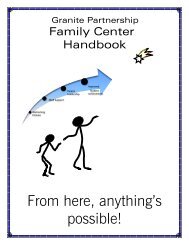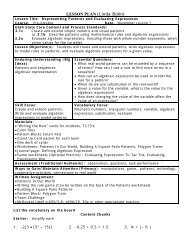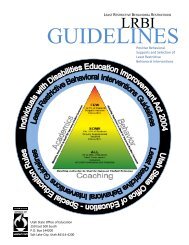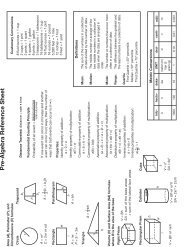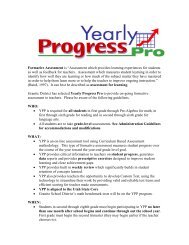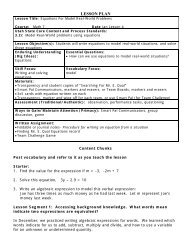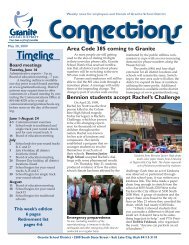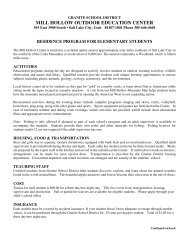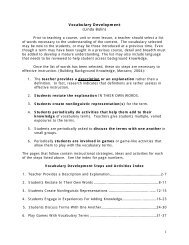Utah Special Education Paraeducator Handbook - Granite School ...
Utah Special Education Paraeducator Handbook - Granite School ...
Utah Special Education Paraeducator Handbook - Granite School ...
Create successful ePaper yourself
Turn your PDF publications into a flip-book with our unique Google optimized e-Paper software.
Standard 1<br />
Support instructional opportunities<br />
“The mediocre teacher tells. The good teacher explains. The superior teacher demonstrates. The great<br />
teacher inspires.” (William A. Ward)<br />
There are many different positions available to<br />
paraeducators. As a paraeducator you may have<br />
accepted a job in a Title I school. You may find yourself<br />
working in a charter school. You may be working with<br />
students who are educationally diverse. The students<br />
you work with may be English Language Learners (ELL).<br />
The students you work with may be receiving special<br />
education services.<br />
The teacher is responsible for<br />
designing and implementing<br />
instruction.<br />
The paraeducator is responsible<br />
for supporting the teacher’s lesson<br />
plans<br />
Title I schools receive additional federal monies that are used to provide educational programs aimed at<br />
ensuring students meet their educational goals. Title1 schools are committed to closing the achievement<br />
gap between low-income students and other students. Students in Title I schools may need special<br />
programs in order to meet these goals.<br />
Charter schools are public schools. They are created by individuals in a community that see educational<br />
needs that may not be met by traditional public schools. Charter schools may use innovative<br />
instructional strategies and focus their curriculum in a particular area such as the arts or sciences.<br />
Charter schools are required to follow the state core curriculum. They are also required to meet federal<br />
guidelines and are assessed for adequate yearly progress just like all other public schools.<br />
English Language Learners are students who are learning English and speak another language as their<br />
first language. These students may have a hard time understanding information in classes that are<br />
taught in English. Federal law requires that states develop policies regarding English language<br />
proficiency. It also requires that English Language Learners be tested in math and reading. These tests<br />
may be given in the student’s native language at first. This means that schools need to work hard to<br />
ensure that students who are English Language Learners receive services that will help them meet<br />
learning goals.<br />
<strong>Special</strong> <strong>Education</strong> is specially designed instruction. There is no cost to parents. It should meet the unique<br />
needs of a student with a disability. This instruction could be in a classroom, at home, in a hospital, an<br />
institution, other settings, or in physical education. <strong>Special</strong> <strong>Education</strong> services could also include<br />
speech/language pathology services, travel training, and applied technology education.<br />
<strong>Special</strong> <strong>Education</strong> students require specialized instruction. In order to meet their unique needs, teachers<br />
often need to rely on help from paraeducators.<br />
<strong>Utah</strong> <strong>Paraeducator</strong> <strong>Handbook</strong> Page 5




